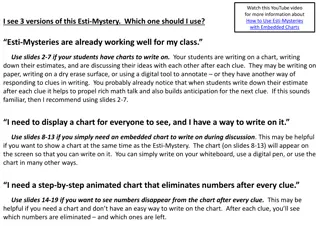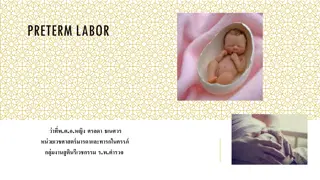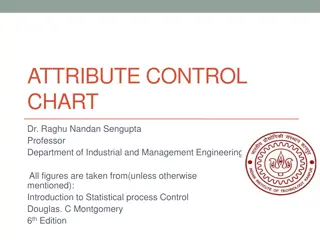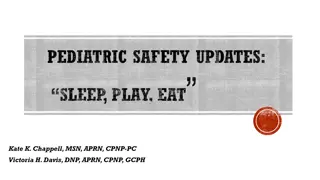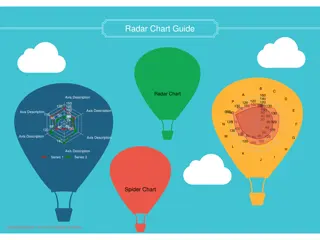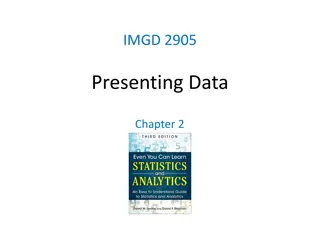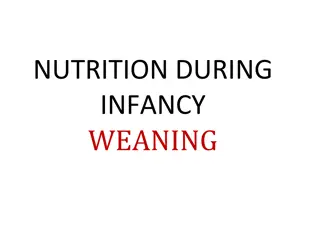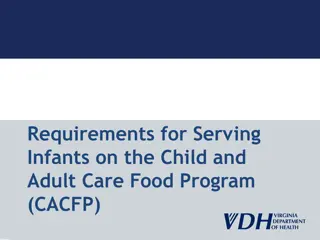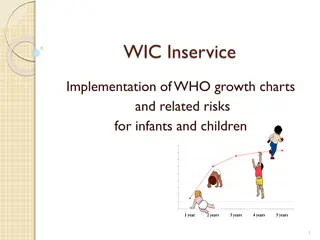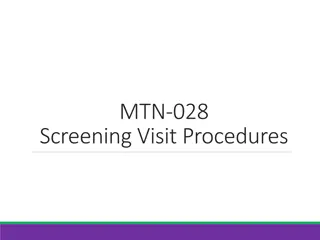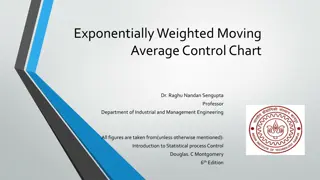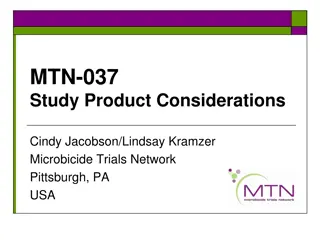Understanding Infant Growth Charts in MTN-016 for Effective Monitoring
Infant growth charts are essential tools used to monitor a child's growth trajectory over time. MTN-016 utilizes WHO growth standards for infants up to one year. Learn how to accurately use growth charts, adjust for gestational age, interpret percentile curves, and describe plotted points. These charts are screening tools that aid in forming a clinical impression and guiding necessary actions for optimal child health.
Uploaded on Sep 19, 2024 | 0 Views
Download Presentation

Please find below an Image/Link to download the presentation.
The content on the website is provided AS IS for your information and personal use only. It may not be sold, licensed, or shared on other websites without obtaining consent from the author. Download presentation by click this link. If you encounter any issues during the download, it is possible that the publisher has removed the file from their server.
E N D
Presentation Transcript
Using Infant Growth Charts in MTN-016 MTN Regional Meeting Refresher Training: October 2012
What are growth charts? Growth charts are a series of percentile curves that show the distribution of body measurements in children over time. MTN-016 uses the WHO growth standards to monitor growth for infants up to one year of age. Growth charts are not diagnostic instruments. They are screening tools that help you form an overall clinical impression for the child being measured. The positions of the individual points on the graph are less important than the overall trajectory of the growth curve over time.
How to use a growth chart Accurately determine age (adjust for gestational age if <36 weeks) Accurately measure weight and recumbent length Plot measurements on appropriate chart Use the percentile lines to assess body size and growth, and monitor growth over time Gather additional history, exam as needed Discuss growth pattern with parent/caregiver and agree on subsequent action if required
Adjust for gestational age A calculator to adjust for gestational age may be found at http://www.mtnstopshiv.org/node/1584
Percentile curves Major percentile curves lie at the 2, 5, 10, 25, 50, 75, 90, 95, and 98thpercentiles Normal growth should fall between the 2nd percentile and the 98thpercentile Infants and children with a length-for-age <2ndpercentile have short stature. Infants and children with a weight-for-age <2ndpercentile are underweight. Main concern in infancy is poor growth underweight/malnutrition, short stature/stunting
Describing a plotted point - 1 If the plotted point is right on or near the percentile line, then in practice the child is described at being at that percentile: E.g. If Point A is on or near the 50th percentile, the child is described as being at the 50thpercentile For the MTN-016 CRF: Enter the number 50 as the percentile
Describing a plotted point - 2 If the plotted point is between percentile lines, then in practice the child is described as being between the two percentiles: E.g. If Point A is between the 50thand 75th percentile, the child is described as being between the 50thand 75thpercentiles For the MTN-016 CRF, we cannot report between percentiles so instead we estimate a percentile in blocks of 5-10% (e.g. 55th, 60th, 65th, 70thpercentile) and record this number on the CRF
Normal growth in a healthy infant Typically follows the same growth curve or trajectory over time. A normal growth curve is between the 2nd and 98thpercentile and parallels the 50th percentile growth trajectory. Weight should be proportional to length An infant should regain birth weight by two weeks of age and then will typically gain 15-30 grams (0.5-1 ounce) per day*
When further investigation is needed Unexplained growth including: Sharp upwards or downwards trend over a short period of time when child crosses one major percentile curve and may be close to crossing a second major percentile curve Growth at <2ndpercentile or >98thpercentile Consistent flat growth trend Concerns such as poor nutritional intake, presence of a chronic illness, etc.
High concern pediatric evaluation Any sharp decline in growth line: This is a very significant change in the child s growth. A sharp decline in a normal or undernourished child indicates a growth disturbance. Changes in weight or length should be investigated before a child crosses two major percentile lines. Pediatric evaluation is recommended
High concern pediatric evaluation A flat growth line: Child is not growing consistently. When growth rate is rapid during first six months of life, even a one month flat line in growth represents a possible concern. Pediatric evaluation is recommended.
High concern pediatric evaluation Any sharp incline in the growth line: This is a very significant change in the child s growth. Changes in weight or length should be investigated before a child crosses two major percentile lines. An unexplained sharp incline may signal a change in feeding practices - may lead to overweight/obesity. A sharp incline in a previously ill or undernourished child may be catch-up growth expected in the re- feeding period. Pediatric evaluation is recommended if weight gain is unexpected.
Practice Scenario - Birth Omar is a 3 month old breastfed male infant: Birth date: 15 APR 2012 Birth weight: 3.41 kg Gestational age: 38 weeks Plot the point and describe his weight-for-age percentile Description: weight-for-age is at the 50thpercentile MTN-016 CRF birth percentile: 50
Practice Scenario Week 1 Visit At Omar's first study visit his mother is concerned that she does not have enough breast milk. Visit date: 24 APR 2012 Visit weight: 3.21 kg Age: 9 days Plot the point and describe his weight-for-age percentile Description: weight-for-age is between the 10thand 25th percentile, but closer to the 25th MTN-016 CRF percentile: 25 Is this expected? What else would you do at this visit?
Practice Scenario Month 1 visit At the Month 1 visit, Omar has not yet regained his birth weight: Visit date: 15 May 2012 Visit weight: 3.35 kg Age: 1 month Plot the point and describe his weight-for-age percentile Description: weight-for-age is at the 2ndpercentile MTN-016 CRF percentile: 2 Is this expected? What else would you do at this visit?
Practice Scenario Interim visit 1 Omar returns for an interim weight check two weeks after his Month 1 visit: Visit date: 30 May 2012 Visit weight: 4.21 kg Age: 1.5 months Plot the point and describe his weight-for-age percentile Description: weight-for-age is at the 10thpercentile MTN-016 CRF percentile: 10 Is this expected? What else would you do at this visit?
Practice Scenario Interim visit 2 Omar returns for an interim weight check one month after his last interim visit: Visit date: 01 July 2012 Visit weight: 5.23 kg Age: 2.5 months Plot the point and describe his weight-for-age percentile Description: weight-for-age is between the 10thand 25th percentiles MTN-016 CRF percentile: 15 Is this expected? What else would you do at this visit?
Practice Scenario Month 6 visit Omar returns for his Month 6 EMBRACE visit: Visit date: 12 OCT 2012 Visit weight: 7.26 kg Age: 6 months Plot the point and describe his weight-for-age percentile Description: weight-for-age is near the 25thpercentile MTN-016 CRF percentile: 25 Is this expected? What else would you do at this visit?



